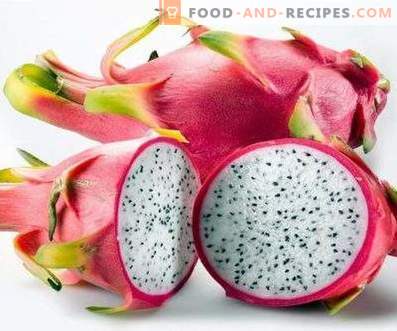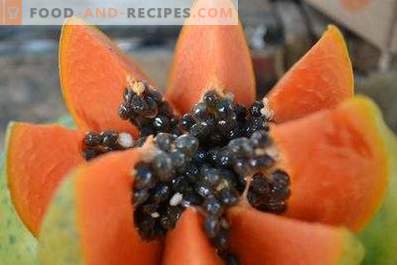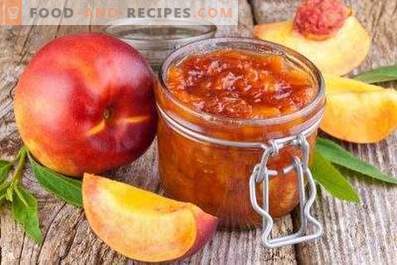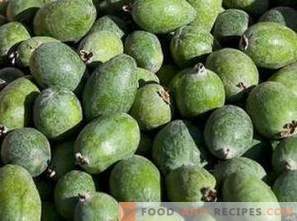
Pitahaya (or dragon fruit) on the shelves of stores in our country does not appear often, but it can still be found in some hypermarkets and in Asian markets. Traveling to Vietnam, Israel, the Philippines and other countries in Asia, Africa and South America, characterized by a dry climate, you will surely pay attention to bright fruits that look like pineapples, but in shape resemble large eggs covered with scales. This is pitahaya, which, according to legend, people conquered from the dragons. Being the owner of this overseas fruit, you will almost certainly be confronted with the question of how to eat it correctly and whether all parts of the fruit are edible. The answer to this question must be obtained before you eat pitahaya for food.
Fetal Information
Pitahaya is the fruit of a cacti family. The culture is unpretentious and gives up to 6 harvests per year, but grows only in hot, dry climates.
Pitahai fruit weighs from 300 g to 1 kg, covered with dense leaves of bright color, green at the tips, which gives pitahaya similar to pineapple. The shape of the fruit is more like an oblong apple.
Under the leaves, forming a kind of peel, is the flesh, the consistency of kiwi flesh, but having a different color. Small unstable seeds, similar to poppy seeds, are found in the pulp.
There are three main varieties of pitahaya:
- Red pitahaya. Has a peel of red or bright pink color, white pulp.
- Pink Pitahaya. It has a rich pink peel and raspberry pulp.
- Yellow pitahaya. The rarest variety. It has a peel of yellow-orange color, white flesh.
To taste, the various varieties of pitahai are not completely identical. It is believed that yellow fruits have the most intense taste and color, red ones have the least pronounced organoleptic qualities. Fans of this fruit claim that its taste is something between a banana and a kiwi.
The chemical composition and beneficial properties of pitahai are little studied, but it is known for certain that the fruit contains large amounts of vitamin C and some B vitamins, as well as phosphorus, potassium, and iron. There is a lot of fiber in fruits.
Among the beneficial properties of pitahaya called strengthening vision, improving immunity, improving mood, preventing cardiovascular diseases. The greatest danger with proper use of Pitahaya is an allergy, there are also known cases of individual intolerance to the fruit.
Usage Features
Edible is only the pitahaya pulp. Some use flowers and plants, adding them to tea. But the peel of the fruit can not be eaten, it is fraught with severe indigestion and other troubles that accompany food poisoning.
Even eating pitahaya pulp can cause adverse reactions in the gastrointestinal tract, leading to allergies. In this regard, people who have not eaten this fruit before, are recommended for the first time not to eat it in large quantities. It is generally undesirable to try people who are prone to allergies and children younger than 3 years old. There are several ways to separate tasty pulp from harmful peel:
- cut the top off and peel from top to bottom, as is done when peeling bananas;
- cut off the top, incise and pull the shell down, freeing the flesh;
- cut the fruit in half lengthwise and eat the contents of the halves using a dessert spoon;
- cut the fruit in half, pick the flesh with a large spoon, trying not to damage it, then cut it into cubes and use it to make desserts.
You will get the pleasure of eating pitahaya only if it is ripe, but not overripe. If the fruits are firm, they have not yet matured. If there are dark spots on the surface, the fruit is overripe and already spoiled, it cannot be eaten.
Pitahaya can be eaten in its pure form, used to prepare various desserts: fruit salad, smoothies, sherbet. Sometimes it is grilled, although gourmets say it tastes best cold. It makes sense to try different types of dishes from pitahaya to form your own opinion on this issue.
Fruit kebab made from pitahaya and kiwi
Composition:
- pitahaya - 0, 3 kg;
- Kiwi - 0, 3 kg;
- icing sugar - to taste.
Method of preparation:
- Wooden skewers soak in water so that they do not burn while cooking kebabs in the oven.
- Cut the pitahaya in half, carefully remove the pulp, cut it into cubes or a similar shape into pieces of about 1.5-2 cm.
- Peel the kiwi fruit with a knife and the same pieces.
- Thread the pieces of pitahaya and kiwi on skewers, alternating them.
- Turn the oven on in grill mode, put the skewers with fruit on the wire rack. Roast 2 minutes.
- Turn the skewers upside down, continue to fry them for 2 minutes.
- Put the skewers on a plate, sprinkle with powdered sugar and serve.
The delicacy prepared according to this recipe will be tasty immediately after cooking and after it has cooled.
Pitahaya Ice Cream Sherbet
Composition:
- pitahaya - 0, 5-0, 7 kg;
- water - 160 ml;
- lemon juice - 40 ml;
- granulated sugar - 40 g.
Method of preparation:
- Having cut the fruit of the pitahaya in half, scrape the pulp with spoons and place it in the blender bowl. Clean the halves themselves - they can be used to beautifully serve sherbet to the table.
- Pitahaya pour water and lemon juice, add sugar.
- Turn on the blender, beat the pitahaya until a completely homogeneous mass is in the bowl.
- Wrap a form with cling film, transfer the fruit mass into it, cover with a second layer of film. Put the form in the freezer for 16 hours. The first 8 hours every 2 hours, mix the sorbet with a spoon.
- Spread the sorbet in half pitahaya, serve it to the table.
It is possible to prepare sherbet in the ice cream maker. The mass for freezing is done the same way, and then the dessert is prepared according to the instructions for the device.
Fruit salad with pitahaya
Composition:
- pitahaya - 0, 3 kg;
- Kiwi - 150 g;
- strawberries - 100 g;
- banana - 150 g;
- yogurt (you can use natural or with strawberry, banana filler) - to taste.
Method of preparation:
- Wash, dry berries and fruits. Fruit peel.
- Cut the flesh of kiwi, banana and pitahaya into cubes of 1-1.5 cm.
- Cut the berries into 2-4 pieces depending on their size.
- Stir in the strawberry and fruit pieces, spread the mixture in an ice cream bowl.
- Pour the preparation with yogurt and serve to the table.
The dessert prepared according to this recipe has a relatively small caloric content and can be used even by those who follow the figure.
Pitahaya is an unusual fruit with edible pulp that resembles kiwi in taste and texture. It can be eaten, without subjecting to heat treatment, in its pure form or used for cooking cold and hot desserts. Pitahaya peel is inedible.























